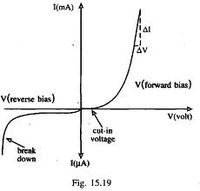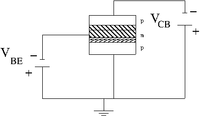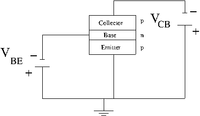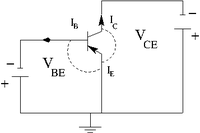Difference between revisions of "TF EIM Chapt5"
| Line 37: | Line 37: | ||
:<math>\Rightarrow I_E = I_B + I_C</math> | :<math>\Rightarrow I_E = I_B + I_C</math> | ||
| − | Here it is the case that the positive current is representing the flow of positively charged holes | + | Here it is the case that the positive current is actually representing the flow of positively charged holes (in non-semi-conductors the current represent the opposite direction of the flowing electrons) |
| Line 44: | Line 44: | ||
The above is not the case. | The above is not the case. | ||
| + | |||
| + | |||
| + | The potential V_{BE} continuously draws electrons out of the emitter thus creating holes in the emitter | ||
=Transistor Physical features= | =Transistor Physical features= | ||
Revision as of 04:03, 8 March 2011
Bipolar Transistor
The Bipolar transistor concept
From the last chapter we saw a p-n junction diode which had similar characteristic current-vs- voltage responses when biased either in the forward direction or backward.
The bottom p-n junction, when forward biased, provides a large current with a small voltage bias.
The top half of the p-n-p transistor is reversed biased, providing a "throttle" for the large current from the lower half.
The electric field points to the "collector" in the depletion region enlarged by the reverse bias. This moves the majority charge carriers away from the collector-base junction. Once outside the depletion zone, the charge carriers rely on diffusion to escape the material.
BIpolar transistor currents
- Conservation of Current
Here it is the case that the positive current is actually representing the flow of positively charged holes (in non-semi-conductors the current represent the opposite direction of the flowing electrons)
You might think that the base current is larger than the collector current because of the reverse bias on the collector which leads to the base having lower resistance than the collector.
The above is not the case.
The potential V_{BE} continuously draws electrons out of the emitter thus creating holes in the emitter
Transistor Physical features
The three layers
A transistor has three semi-conductor payers. The three layers occur in the order of
p-n-p= holes-electron-hole
n-p-n= electron-hole-electron
The three layers are formed from a single crystal such that the doping of the single crystal defines the boundaries. The three layers are not "glued" together.





